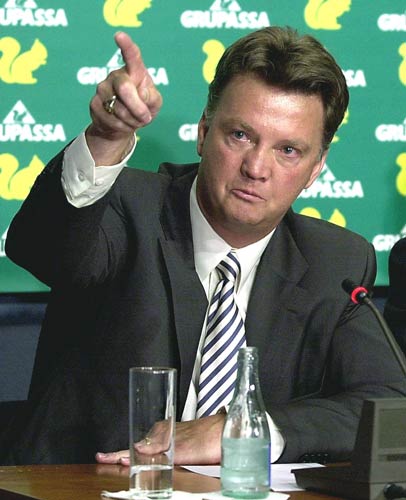He definitely made a great work and gave his doubters no chance
Secrets of Bayern’s ungainly schoolmaster
Published: March 26 2010 16:57 | Last updated: March 26 2010 16:57
Louis van Gaal, Bayern Munich’s coach, was celebrating a goal when he fell over. The scorer, Arjen Robben, had run up to hug him but instead jumped on top of him. Eventually Van Gaal stumbled into his dug-out, blushing and with a bloodied finger. The hug is already a Youtube classic in Germany.
Everything about Bayern’s Dutch coach is ungainly. He is flat-faced, pot-bellied, and brandishes a notebook at the unlikeliest moments. Being a football manager is mostly a presentational job, and Van Gaal does that terribly. He has only one saving grace: he’s brilliant. He’s that rare manager who consistently improves his teams’ performances. Before Bayern meet Manchester United in the Champions League quarterfinal on Tuesday, it’s worth overlooking the persona and studying his secrets.
Van Gaal was born in Amsterdam in 1951 with the brain of a great footballer. Unluckily, he was also flabby and slow. He played semi-professional football, and taught gym at a school for difficult youths. The day job taught him how to explain. If the kids couldn’t hit a baseball, Van Gaal would talk until they could. He was equipping himself for his destiny.
In 1991 he became coach of Ajax Amsterdam. Like most Dutchmen, he viewed football as a dance in space. His teams passed the ball around endlessly, searching for spaces the opposition let fall. Yet Van Gaal searched more methodically than anyone else. Like a coach in American gridiron, he told each player precisely where to move. His forwards ran set patterns to free themselves from defenders, like wide receivers in American football.
Collectief was Van Gaal’s favourite Dutch word. He interviewed prospective signings to see if they were collectivist enough. In 1995 Van Gaal won the Champions League with practically a boys’ team.
He struggled only off the field. Even the famously blunt Dutch thought he was blunt. “Are you so dumb or am I so clever?” he asked one journalist. At Barcelona, he squabbled with his best player, Rivaldo. That one man’s dribbles could win matches struck Van Gaal as absurdly random. He offended everyone at Barca, yet won two Spanish titles in three years.
“He really notices every detail,” remarked Barcelona’s captain, Josep Guardiola. At Barca, Van Gaal found another pupil, a young interpreter named José Mourinho, who wrote scouting reports for him. Guardiola and Mourinho have since joined Van Gaal in the small pantheon of great managers.
After flopping as coach of Holland, Van Gaal saw that defences had become too sharp to succumb to endless passing. Like Arsène Wenger at Arsenal, he began focusing on the instant when a team loses the ball. It’s the moment – omschakeling – when the opposition’s defence might be out of position. When Van Gaal made little AZ Alkmaar Dutch champions last season, they struck on the omschakeling.
Armed only with a Dutch-German dictionary, he came to Munich and irritated everyone. Van Gaal will talk players through wrong decisions taken in training kickarounds. Eventually Bayern’s players absorbed his instructions. They haven’t stopped winning since.
This Bayern side bears Van Gaal’s old hallmarks, and new ones, too. He still disdains reputations. Germans thought Bastian Schweinsteiger was an international forward. Van Gaal realised “Schweini” was a defensive midfielder. The obsession with detail persists: when the opponents have possession, Bayern’s striker harries their defenders, not in order to win the ball but to pressure a pass to central midfield, where Bayern will win it.
But the new Van Gaal relies on dribbling to open today’s tight defences. Bayern employ two great soloists, Robben and Franck Ribéry. When Ribéry begins a dribble, his team-mates have precise instructions to move away and clear space for him. Van Gaal still looks like an enraged schoolmaster. The trick is to see only the work





